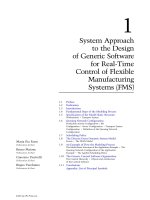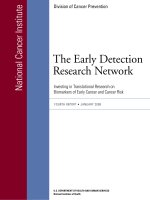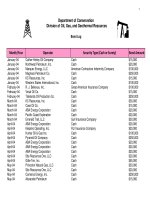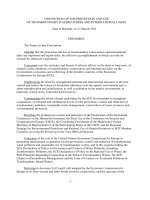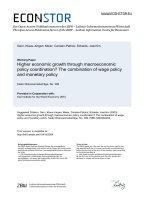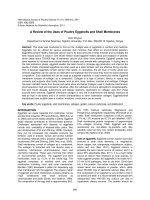Tissue Engineering II Basics of Tissue Engineering and Tissue Applications doc
Bạn đang xem bản rút gọn của tài liệu. Xem và tải ngay bản đầy đủ của tài liệu tại đây (4.46 MB, 344 trang )
103
Advances in Biochemical
Engineering/Biotechnology
Series Editor: T. Scheper
Editorial Board:
W.Babel·I.Endo·S O.Enfors·A.Fiechter·M.Hoare·W S.Hu
B. Mattiasson ·J. Nielsen ·H. Sahm · K. Schügerl · G. Stephanopoulos
U. von Stockar · G. T. Tsao · C. Wandrey · J J. Zhong
Advances in Biochemical Engineering/Biotechnology
Series Editor: T. Scheper
Recently Published and Forthcoming Volumes
White Biotechnology
Volume Editors: Ulber, R., Sell, D.
Vol. 105, 2007
Analytics of Protein-DNA Interactions
VolumeEditor:Seitz,H.
Vol. 104, 2007
Tissue Engineering II
Basics of Tissue Engineering and Tissue
Applications
Volume Editors: Lee, K., Kaplan, D.
Vol. 103, 2007
Tissue Engineering I
Scaffold Systems for Tissue Engineering
Volume Editors: Lee, K., Kaplan, D.
Vol. 102, 2006
Cell Culture Engineering
Volume Editor: Hu, W S.
Vol. 101, 2006
Biotechnology for the Future
Volume Editor: Nielsen, J.
Vol. 100, 2005
Gene Therapy and Gene Delivery Systems
Volume Editors: Schaffer, D. V., Zhou, W.
Vol. 99, 2005
Sterile Filtration
Volume Editor: Jornitz, M. W.
Vol. 98, 2006
Marine Biotechnology II
Volume Editors: Le Gal, Y., Ulber, R.
Vol. 97, 2005
Marine Biotechnology I
Volume Editors: Le Gal, Y., Ulber, R.
Vol. 96, 2005
Microscopy Techniques
Volume Editor: Rietdorf, J.
Vol. 95, 2005
Regenerative Medicine II
Clinical and Preclinical Applications
Volume Editor: Yannas, I. V.
Vol. 94, 2005
Regenerative Medicine I
Theories, Models and Methods
Volume Editor: Yannas, I. V.
Vol. 93, 2005
Technology Transfer in Biotechnology
VolumeEditor:Kragl,U.
Vol. 92, 2005
Recent Progress of Biochemical and Biomedical
Engineering in Japan II
Volume Editor: Kobayashi, T.
Vol. 91, 2004
Recent Progress of Biochemical and Biomedical
Engineering in Japan I
Volume Editor: Kobayashi, T.
Vol. 90, 2004
Physiological Stress Responses in Bioprocesses
Volume Editor: Enfors, S O.
Vol. 89, 2004
Molecular Biotechnology of Fungal β-Lactam
Antibiotics and Related Peptide Synthetases
Volu me E ditor : B rakhage, A.
Vol. 88, 2004
Biomanufacturing
Volume Editor: Zhong, J J.
Vol. 87, 2004
New Trends and Developments in Biochemical
Engineering
Vol. 86, 2004
Tissue Engineering II
Basics of Tissue Engineering and Tissue Applications
Volume Editors: Kyongbum Lee · David Kaplan
With contributions by
J. P. Acker · E. S. Ahn · S. T. Andreadis · F. Berthiaume · S. N. Bhatia
R.J.Fisher·J.A.Garlick·Y.Nahmias·R.A.Peattie·V.L.Tsang
T. J. Webster · M. L. Yarmush
123
Advances in Biochemical Engineering/Biotechnology reviews actual trends in modern biotechnology.
Its aim is to cover all aspects of this interdisciplinary technology where knowledge, methods and
expertise are required for chemistry, biochemistry, micro-biology, genetics, chemical engineering and
computer science. Special volumesare dedicated to selected topics which focus on newbiotechnological
products and new processes for their synthesis and purification. They give the state-of-the-art of
a topic in a comprehensive way thus being a valuable source for the next 3–5 years. It also discusses
new discoveries and applications. Special volumes are edited by well known guest editors who invite
reputed authors for the review articles in their volumes.
In references Advances in Biochemical Engineering/Biotechnology is abbeviated Adv Biochem En-
gin/Biotechnol and is cited as a journal.
Springer WWW home page: springer.com
Visit the ABE content at springerlink.com
Library of Congress Control Number: 2006929797
ISSN 0724-6145
ISBN-10 3-540-36185-5 Springer Berlin Heidelberg New York
ISBN-13 978-3-540-36185-5 Springer Berlin Heidelberg New York
DOI 10.1007/11749219
This work is subject to copyright. All rights are reserved, whether the whole or part of the material
is concerned, specifically the rights of translation, reprinting, reuse of illustrations, recitation, broad-
casting, reproduction on microfilm or in any other way, and storage in data banks. Duplication of
this publication or parts thereof is permitted only under the provisions of the German Copyright Law
of September 9, 1965, in its current version, and permission for use must always be obtained from
Springer. Violations are liable for prosecution under the German Copyright Law.
Springer is a part of Springer Science+Business Media
springer.com
c
Springer-Verlag Berlin Heidelberg 2007
The use of registered names, trademarks, etc. in this publication does not imply, even in the absence
of a specific statement, that such names are exempt from the relevant protective laws and regulations
and therefore free for general use.
Cover design: WMXDesign GmbH, Heidelberg
Typesetting and Production: LE-T
E
XJelonek,Schmidt&VöcklerGbR,Leipzig
Printed on acid-free paper 02/3141 YL – 5 4 3 2 1 0
Series Editor
Prof. Dr. T. Scheper
Institute of Technical Chemistry
University of Hannover
Callinstraße 3
30167 Hannover, Germany
Volume Editors
Prof. Dr. Kyongbum Lee
Assistant Professsor
Chemical and Biological Engineering
Tufts University
4 Colby Street, Room 142
Medford, MA 02155, USA
Prof. Dr. David Kaplan
Professor and Chair
Department of Biomedical Engineering
Science and Technology Center
Medford, MA 02155, USA
Editorial Board
Prof. Dr. W. Babel
Section of Environmental Microbiology
Leipzig-Halle GmbH
Permoserstraße 15
04318 Leipzig, Germany
Prof. Dr. S O. Enfors
Department of Biochemistry and
Biotechnology
Royal Institute of Technology
Teknikringen 34,
100 44 Stockholm, Sweden
Prof. Dr. M. Hoare
Department of Biochemical Engineering
University College London
Torrington Place
London,WC1E7JE,UK
Prof. Dr. I. Endo
Saitama Industrial Technology Center
3-12-18, Kamiaoki Kawaguchi-shi
Saitama, 333-0844, Japan
Prof. Dr. A. Fiechter
Institute of Biotechnology
Eidgenössische Technische Hochschule
ETH-Hönggerberg
8093 Zürich, Switzerland
ae.fi
VI Editorial Board
Prof. Dr. W S. Hu
Chemical Engineering
and Materials Science
University of Minnesota
421 Washington Avenue SE
Minneapolis, MN 55455-0132, USA
Prof. Dr. B. Mattiasson
Department of Biotechnology
Chemical Center, Lund University
P.O. Box 124, 221 00 Lund, Sweden
Prof. Dr. H. Sahm
Institute of Biotechnolgy
Forschungszentrum Jülich GmbH
52425 Jülich, Germany
Prof. Dr. G. Stephanopoulos
Department of Chemical Engineering
Massachusetts Institute of Technology
Cambridge, MA 02139-4307, USA
Prof. Dr. G. T. Tsao
Professor Emeritus
Purdue University
West Lafayette, IN 47907, USA
Prof. Dr. J J. Zhong
College of Life Science & Biotechnology
Shanghai Jiao Tong University
800 Dong-Chuan Road
Minhang, Shanghai 200240, China
Prof. Dr. J. Nielsen
Center for Process Biotechnology
Technical University of Denmark
Building 223
2800 Lyngby, Denmark
Prof. Dr. K. Schügerl
Institute of Technical Chemistry
University of Hannover, Callinstraße 3
30167 Hannover, Germany
Prof. Dr. U. von Stockar
Laboratoire de Génie Chimique et
Biologique (LGCB), Départment de Chimie
Swiss Federal Institute
of Technology Lausanne
1015 Lausanne, Switzerland
urs.vonstockar@epfl.ch
Prof. Dr. C. Wandrey
Institute of Biotechnology
Forschungszentrum Jülich GmbH
52425 Jülich, Germany
Advances in Biochemical Engineering/Biotechnology
Also Available Electronically
For all customers who have a standing order to Advances in Biochemical
Engineering/Biotechnology, we offer the electronic version via SpringerLink
free of charge. Please contact your librarian who can receive a password or free
access to the full articles by registering at:
springerlink.com
If you do not have a subscription, you can still view the tables of contents of the
volumes and the abstract of each article by going to the SpringerLink Home-
page, clicking on “Browse by Online Libraries”, then “Chemical Sciences”, and
finally choose Advances in Biochemical Engineering/Biotechnology.
You will find information about the
– Editorial Board
–AimsandScope
– Instructions for Authors
–SampleContribution
at springer.com using the search function.
Attention all Users
of the “Springer Handbook of Enzymes”
Information on this handbook can be found on the internet at
springeronline.com
A complete list of all enzyme entries either as an alphabetical Name Index or
as the EC-Number Index is available at the above mentioned URL. You can
download and print them free of charge.
Acompletelistofall synonyms(morethan25,000entries) used for the enzymes
is available in print form (ISBN 3-540-41830-X).
Save 15%
We recommend a standing order for the series to ensure you automatically
receive all volumes and all supplements and save 15% on the list price.
Preface
It is our pleasure to present this special volume on tissue engineering in the
series Advances in Biochemical Engineering and Biotechnology.Thisvolume
reflects the emergence of tissue engineering as a core discipline of modern
biomedical engineering, and recognizes the growing synergies between the
technological developments in biotechnology and biomedicine. Along this
vein,thefocusofthisvolumeistoprovideabiotechnologydrivenperspective
on cell engineering fundamentals while highlighting their significance in pro-
ducing functional tissues. Our aim is to present an overview of the state of the
art of a selection of these technologies, punctuated with current applications
in the research and development of cell-based therapies for human disease.
To prepare this volume, we have solicited contributions from leaders and
experts in their respective fields, ranging from biomaterials and bioreactors
to gene delivery and metabolic engineering. Particular emphasis was placed
on including reviews that discuss various aspects of the biochemical pro-
cesses underlying cell function, such as signaling, growth, differentiation, and
communication. The reviews of research topics cover two main areas: cellu-
lar and non-cellular components and assembly; evaluation and optimization
of tissue function; and integrated reactor or implant system development for
researchandclinical applications. Many of thereviewsillustratehowbiochemi-
cal engineering methods are used to produce and characterize novel materials
(e.g. genetically engineered natural polymers, synthetic scaffolds with cell-
type specific attachment sites or inductive factors), whose unique properties
enable increased levels of control over tissue development and architecture.
Other reviews discuss the role of dynamic and steady-state models and other
informatics tools in designing, evaluating, and optimizing the biochemical
functions of engineered tissues. Reviews that illustrate the integration of these
methods and models in constructing model, implant (e.g. skin, cartilage), or
ex-vivo systems (e.g. bio-artificial liver) are also included.
It is our expectation that the mutual relevance of tissue engineering and
biotechnology will only increase in the coming years,asour needs for advanced
healthcare products continue to grow. Already, tissue derived cells constitute
important production systems for therapeutically and otherwise useful bio-
moleculesthat require specialized post-translational processing fortheir safety
andefficacy. Biochemical engineering products, ranging from growth factorsto
X Preface
polymer scaffolds, are used as building blocks or signal molecules at virtually
every stage of engineered tissue formation. Importantly, the realization of
engineered tissues as clinically useful and commercially viable products will
at least in part depend on overcoming the same efficiency challenges that
the biotechnology industry has been facing. In this light, we see the interface
betweentissueengineering andvarious other fields of biochemical engineering
as a very exciting area for research and development with enormous potential
for cross-disciplinary education. In this regard, we anticipate that this and
other similar volumes will also be useful as supplementary text for students.
We extend our special thanks to all of the contributing authors as well
as Springer for embarking on this project. We are especially grateful to Dr.
Thomas Scheper and Ulrike Kreusel for their incredible patience and hard
work as our production editors.
Medford, August 2006 Kyongbum Lee, David Kaplan
Contents
Controlling Tissue Microenvironments: Biomimetics,
Transport Phenomena, and Reacting Systems
R.J.Fisher·R.A.Peattie 1
Perfusion Effects and Hydrodynamics
R.A.Peattie·R.J.Fisher 75
Biopreservation of Cells and Engineered Tissues
J.P.Acker 157
Fabrication of Three-Dimensional Tissues
V.L.Tsang·S.N.Bhatia 189
Engineering Skin to Study Human Disease –
Tissue Models for Cancer Biology and Wound Repair
J.A.Garlick 207
Gene-Modified Tissue-Engineered Skin: The Next Generation
of Skin Substitutes
S.T.Andreadis 241
Nanostructured Biomaterials for Tissue Engineering Bone
T.J.Webster·E.S.Ahn 275
Integration of Technologies for Hepatic Tissue Engineering
Y.Nahmias·F.Berthiaume·M.L.Yarmush 309
Author Index Volumes 100–103 331
Subject Index 333
Contents of Volume 102
Tissue Engineering I
Volume Editors: Kyongbum Lee, David Kaplan
ISBN: 3-540-36185-5
Tissue Assembly Guided via Substrate Biophysics: Applications
to Hepatocellular Engineering
E.J.Semler·C.S.Ranucci·P.V.Moghe
Polymers as Biomaterials for Tissue Engineering and Controlled
Drug Delivery
L.S.Nair·C.T.Laurencin
Interface Tissue Engineering and the Formulation of Multiple-Tissue Systems
H. H. Lu · J. Jiang
Cell Instructive Polymers
T. Matsumoto · D. J. Mooney
Cellular to Tissue Informatics: Approaches to Optimizing Cellular Function
of Engineered Tissue
S. Patil · Z. Li · C. Chan
Biodegradable Polymeric Scaffolds. Improvements
in Bone Tissue Engineering through Controlled Drug Delivery
T. A. Holland · A. G. Mikos
Biopolymer-Based Biomaterials as Scaffolds for Tissue Engineering
J. Velema · D. Kaplan
Contents of Advances in Polymer Science, Vol. 203
Polymers for Regenerative Medicine
Volume Editor: Carsten Werner
ISBN: 3-540-33353-3
Biopolyesters in Tissue Engineering Applications
T. Freier
Modulating Extracellular Matrix at Interfaces of Polymeric Materials
C.Werner·T.Pompe·K.Salchert
Hydrogels for Musculoskeletal Tissue Engineering
S. Varghese · J. H. Elisseeff
Self-Assembling Nanopeptides Become a New Type of Biomaterial
X. Zhao · S. Zhang
Interfaces to Control Cell-Biomaterial Adhesive Interactions
A. J. García
Polymeric Systems for Bioinspired Delivery of Angiogenic Molecules
C. Fischbach · D. J. Mooney
Adv Biochem Engin/Biotechnol (2006) 103: 1–73
DOI 10.1007/10_018
© Springer-Verlag Berlin Heidelberg 2006
Published online: 5 July 2006
Controlling Tissue Microenvironments:
Biomimetics, Transport Phenomena, and Reacting
Systems
Robert J. Fisher
1
·RobertA.Peattie
2
(✉)
1
Department of Chemical Engineering, Building 66, Room 446,
Massachusetts Institute of Technology, Cambridge, MA 02139, USA
2
Department of Chemical Engineering, Oregon State University, 102 Gleeson Hall,
Corvallis, OR 97331, USA
1Introduction 3
1.1 OverviewandMotivation 3
1.2 BackgroundandApproach 4
2 Tissue Microenvironments 6
2.1 SpecifyingPerformanceCriteria 6
2.2 EstimatingTissueFunction 6
2.2.1 BloodMicroenvironment 6
2.2.2 BoneMarrowMicroenvironment 7
2.3 Communication 8
2.3.1 CellularCommunicationWithinTissues 8
2.3.2 SolubleGrowthFactors 9
2.3.3 DirectCell-to-CellContact 9
2.3.4 ExtracellularMatrixandCell–TissueInteractions 10
2.3.5 CommunicationwiththeWholeBodyEnvironment 11
2.4 Cellularity 12
2.5 Dynamics 13
2.6 Geometry 14
2.7 SystemInteractions 14
2.7.1 CompartmentalAnalysis 15
2.7.2 Blood–BrainBarrier 26
2.7.3 CellCultureAnalog(CCA):AnimalSurrogateSystem 28
3 Biomimetics 30
3.1 FundamentalsofBiomimicry 30
3.1.1 MorphologyandPropertiesDevelopment 31
3.1.2 MolecularEngineering 31
3.1.3 BiotechnologyandEngineeringBiosciences 32
3.2 BiomimeticMembranes:IonTransport 32
3.2.1 ActiveTransportBiomimetics 33
3.2.2 FacilitatedTransportviaFixedCarriers 34
3.2.3 FacilitatedTransportviaMobileCarriers 34
3.3 BiomimeticReactors 35
3.3.1 UncouplingMassTransferResistances 35
3.3.2 PharmacokineticsandCCASystems 35
2R.J.Fisher·R.A.Peattie
3.4 ElectronTransferChainBiomimetics 37
3.4.1 MimicryofInVivoCoenzymeRegeneration 37
3.4.2 Electro-EnzymaticMembraneBioreactors 38
3.5 BiomimicryandtheVascularSystem 38
3.5.1 HollowFiberSystems 39
3.5.2 PulsatileFlowinBiomimeticBloodVessels 40
3.5.3 AbdominalAorticAneurysmEmulation 43
3.5.4 StimulationofAngiogenesiswithBiomimeticImplants 45
4 Transport Phenomena 46
4.1 MassTransfer 47
4.1.1 MembranePhysicalParameters 49
4.1.2 Permeability 49
4.1.3 DextranDiffusivity 50
4.1.4 MarkerMoleculeDiffusivity 51
4.1.5 InterpretingExperimentalResults 53
4.2 HeatTransfer 53
4.2.1 ModelsofPerfusedTissues:ContinuumApproach 54
4.2.2 AlternativeApproaches 55
4.3 MomentumTransfer 56
5ReactingSystems 58
5.1 MetabolicPathwayStudies:EmulatingEnzymaticReactions 58
5.2 Bioreactors 61
5.2.1 ReactorTypes 61
5.2.2 DesignofMicroreactors 63
5.2.3 Scale-up 64
5.2.4 PerformanceandOperationalMaps 64
5.3 IntegratedSystems 65
6 Capstone Illustration: Control of Hormone Diseases via Tissue Therapy .66
6.1 SelectionofDiabetesasRepresentativeCaseStudy 66
6.2 EncapsulationMotif:SpecificationsandDesign 67
References 70
Abstract The reconstruction of tissues ex vivo and production of cells capable of main-
taining a stable performance for extended time periods in sufficient quantity for syn-
thetic or therapeutic purposes are primary objectives of tissue engineering. The ability
to characterize and manipulate the cellular microenvironment is critical for success-
ful implementation of such cell-based bioengineered systems. As a result, knowledge of
fundamental biomimetics, transport phenomena, and reaction engineering concepts is
essential to system design and development.
Once the requirements of a specific tissue microenvironment are understood, the
biomimetic system specifications can be identified and a design implemented. Utilization
of novel membrane systems that are engineered to possess unique transport and reactive
features is one successful approach presented here. The limited availability of tissue or
cells for these systems dictates the need for microscale reactors. A capstone illustration
based on cellular therapy for type 1 diabetes mellitus via encapsulation techniques is pre-
sented as a representative example of this approach, to stress the importance of integrated
systems.
Controlling Tissue Microenvironments 3
Keywords Autoimmune and hormone diseases · Biomimetics · Cell/tissue therapy ·
Cell culture analogs · Diabetes · Encapsulation motifs · Intelligent membranes ·
Microenvironment · Microreactors · Reaction engineering · Reacting systems · Transport
phenomena · Tissue engineering
1
Introduction
1.1
Overview and Motivation
Major thrust areas of research programs in the evolving arena of the engin-
eering biosciences are based upon making significant contributions in the
fields of pharmaceutical engineering (drug production, delivery, targeting,
and metabolism), molecular engineering (biomaterial design and biomimet-
ics), biomedical reaction engineering (microreactor design, animal surrogate
systems, artificial organs, and extracorporeal devices), and metabolic process
control (receptor–ligand binding, signal transduction, and trafficking). Since
an understanding of the cell/tissue environment can have a major impact on
all of these areas, the ability to characterize, control, and ultimately manipu-
late the cell microenvironment is critical for successful bioengineered system
performance. Four major challenges for the tissue engineer, as identified
by many sources (e.g., [1]), are: (1) proper reconstruction of the microen-
vironment for the development of tissue function, (2) scale-up to generate
a significant amount of properly functioning microenvironments to be of
clinical importance, (3) automation of cellular therapy systems/devices to op-
erate and perform at clinically meaningful scales, and (4) implementation
in the clinical setting in concert with all the cell handling and preservation
procedures required to administer cellular therapies. The first two of these is-
sues belong primarily in the domain of the research community, whereas the
latter two tend to be the responsibility of the commercial sector. Of course,
there is significant overlap of emphasis. Without proper coordination of activ-
ities, the ultimate goal of a successfully engineered tissue cannot be achieved.
A philosophy upheld by many is that a thorough understanding of the fun-
damentals developed when addressing the first two issues forms the basis for
the latter two, and thus implementation of these technologies. Since most tis-
sue engineering groups are concerned with the concepts of how functional
tissue can be built, reconstructed, and modified, this chapter is directed to-
ward supporting efforts within that framework. Consequently, the primary
objective of this chapter is to introduce the fundamental concepts employed
by tissue engineers in reconstructing tissues ex vivo and producing cells of
sufficient quantity that maintain a stabilized performance for extended time
periods of clinical relevance. The concepts and techniques necessary for the
4R.J.Fisher·R.A.Peattie
understanding and use of biomimetics, transport phenomena, and reacting
systems are presented as focal topics. These concepts are paramount in our
ability to understand and control the cell/tissue microenvironment. The de-
livery of cellular therapies, as a goal, was selected as one representative theme
for illustration.
1.2
Background and Approach
Before useful ex vivo and in vitro systems for the numerous applications pre-
sented above can be developed, we must have an appreciation of cellular func-
tion in vivo. Knowledge of the tissue microenvironment and communication
with other organs is essential, since the key questions of tissue engineering
are: how can tissue function be built, reconstructed, and/or modified? To an-
swer these questions, we develop a standard approach based on the following
axioms [1]: (1) in organogenesis and wound healing, proper cellular commu-
nications are of paramount concern since a systematic and regulated response
is required from all participating cells; (2) the function of fully formed or-
gans is strongly dependent on the coordinated function of multiple cell types,
with tissue function based on multicellular aggregates; (3) the functional-
ity of an individual cell is strongly affected by its microenvironment (within
a characteristic length of 100 µm); and (4) this microenvironment is further
characterized by (a) neighboring cells, i.e., cell–cell contact and the presence
of molecular signals (soluble growth factors, signal transduction, trafficking,
etc.), (b) transport processes and physical interactions with the extracellular
matrix (ECM), and (c) the local geometry, in particular its effects on micro-
circulation.
The importance of the microcirculation is that it connects all the microen-
vironments in every tissue to their larger whole body environment. Most
metabolically active cells in the body are located within a few hundred mi-
crometers from a capillary. This high degree of vascularity is necessary to
provide the perfusion environment that connects every cell to a source and
sink for respiratory gases, a source of nutrients from the small intestine, hor-
mones from the pancreas, liver, and endocrine system, clearance of waste
products via the kidneys and liver, delivery of immune system respondents,
and so forth [2]. Further, the three-dimensional arrangement of microvessels
in any tissue bed is critical for efficient functioning of the tissue. Microves-
sel networks develop in vivo in response to physicochemical and molecular
clues. Thus, since the steric arrangement of such developing networks cannot
be predicted in advance at present, reproduction of the microenvironment
with its attendant signal molecule content is an essential feature of engineered
tissues.
The engineering of mechanisms to properly replace the role of neigh-
boring cells, the extracellular matrix, cyto-/chemokine and hormone traf-
Controlling Tissue Microenvironments 5
ficking, microvessel geometry, the dynamics of respiration, and transport
of nutrients and metabolic by-products ex vivo is the domain of bioreac-
tor design [3, 4], a topic discussed briefly in this chapter and elsewhere
in this volume. Cell culture devices must appropriately simulate and pro-
vide these macroenvironmental functions while respecting the need for the
formation of microenvironments. Consequently, they must possess perfu-
sion characteristics that allow for uniformity down to the 100 micrometer
length scale. These are stringent design requirements that must be addressed
with a high priority for each tissue system considered. All these dynamic,
chemical, and geometric variables must be duplicated as accurately as pos-
sible to achieve proper reconstitution of the microenvironment. Since this
is a difficult task, a significant portion of this chapter is devoted to de-
veloping quantitative methods to describe the cell-scale microenvironment.
Once available, these methods can be used to develop an understanding
of key problems, formulate solution strategies, and analyze experimental
results. It is important to stress that most useful analyses in tissue engin-
eering are performed with approximate calculations based on physiological
and cell biological data; basically, determining tissue “specification sheets”.
Such calculations are useful for interpreting organ physiology, and provide
a starting point for the more extensive experimental and computational pro-
grams needed to fully identify the specific needs of a given tissue system
(examples are given below). Using the tools obtained from studying subjects
such as biomimetics (materials behavior, membrane development, and simili-
tude/simulation techniques), transport phenomena (mass, heat, and momen-
tum transfer), reaction kinetics, and reactor performance/design, systems
that control microenvironments for in vivo, ex vivo, or in vitro applications
can be developed.
The approach taken in this chapter to achieve the desired tissue microenvi-
ronments is through the use of novel membrane systems designed to possess
unique features for the specific application of interest, and in many cases
to exhibit stimulant/response characteristics. These “intelligent” or “smart”
membranes are the result of biomimicry, that is, they have biomimetic fea-
tures. Through functionalized membranes, typically in concerted assemblies,
these systems respond to external physical and chemical stresses to either re-
duce stress characteristics or modify and/or protect the microenvironment.
An example is a microencapsulation motif for beta cell islet clusters, to per-
form as an artificial pancreas (Sect. 6.2). The microencapsulation motif uses
multiple membrane materials, each with its unique characteristics and per-
formance requirements, coupled with nanospheres dispersed throughout the
matrix that contain additional materials for enhanced transport and/or bar-
rier properties and respond to specific stimuli. This chapter is structured so
as to lead to beta cell microencapsulation as a capstone example of developing
understanding and use of the technologies appropriate to design bioengi-
neered systems and to ensure their stable performance.
6R.J.Fisher·R.A.Peattie
2
Tissue Microenvironments
Our approach is first to understand the requirements of specific tissue sys-
tems and to know how the microenvironment of each meets its particular
needs. This requires an understanding of the microenvironment composition,
functionality (including communication), cellularity, dynamics, and geom-
etry. Since only a preliminary discussion of these topics is given here, the
reader should refer to additional sources [1, 3, 5, 6], as well as other chapters
in this volume, for a more in-depth understanding.
2.1
Specifying Performance Criteria
Each tissue or organ undergoes its own unique and complex embryonic de-
velopmental program. There are, however, a number of common features of
each component of the microenvironment that are discussed in subsequent
sections with the idea of establishing general criteria to guide system design.
Specific requirements for the application in question are then obtained from
the given tissue’s “spec sheet”. Two representative types of microenvironments
(blood and bone) are briefly compared below to illustrate these common fea-
tures and distinctions. As common examples discussed by many other authors
(see [1, 3, 5, 6] for more details), blood and bone are particularly suitable exam-
ples for which physiologic and cell biologic data are well understood.
2.2
Estimating Tissue Function
2.2.1
Blood Microenvironment
To fulfill its physiological respiratory functions, blood needs to deliver about
10 mM of oxygen per minute to the body. Given a gross circulation rate of
about 5 l/min, the delivery rate to tissues is about 2 mM oxygen per liter
during each pass through its circulatory system. The basic requirements that
circulating blood must meet to deliver adequate oxygen to tissues are deter-
mined by the following: blood leaving the lungs has an O
2
partial pressure
between 90 and 100 mm Hg, which falls to 35–40 mm Hg in the venous blood
at rest and to about 27 mm Hg during strenuous exercise. Consequently, oxy-
gen delivery to the tissues is driven by a partial pressure drop of about 55 mm
Hg on average. Unfortunately, the solubility of oxygen in aqueous media is
low. Its solubility is given by a Henry’s law relationship, in which the liquid-
phase concentration is linearly proportional to its partial pressure with an
equilibrium coefficient of about 0.0013 mM/mm Hg. Oxygen delivery from
Controlling Tissue Microenvironments 7
stores directly dissolved in plasma is therefore limited to roughly 0.07 mM,
significantly below the required 2 mM.
As a result, the solubility of oxygen in blood must be enhanced by some
other mechanism to account for this increase (by a factor of about 30 at rest
and 60 during strenuous exercise). Increased storage is of course provided by
hemoglobin within red blood cells. However, to see how this came about, let’s
probealittlefurther.Althoughenhancementcouldbeobtainedbyputtingan
oxygen binding protein into the perfusion fluid, to stay within the vascular
bed this protein would have to be 50–100 kDa in size. With only a single bind-
ing site, the required protein concentration is 500–1000 g/L, too concentrated
from both an osmolarity and viscosity (10×) standpoint and clearly imprac-
tical. Furthermore, circulating proteases will lead to a short plasma half-life
for these proteins. By increasing to four sites per oxygen-carrying molecule,
the protein concentration is reduced to 2.3 mM and confining it within a pro-
tective cell membrane solves the escape, viscosity, and proteolysis problems.
Obviously, nature has solved these problems, since these are characteristics
of hemoglobin within red blood cells. Furthermore, a more elaborate kinetics
study of the binding characteristics of hemoglobin shows that a positive co-
operativity exists, and can provide large O
2
transport capabilities both at rest
and under strenuous exercise.
These functions of blood present standards for tissue engineers, but are
difficult to mimic. When designing systems for in vivo applications, pro-
moting angiogenesis and minimizing diffusion lengths help alleviate oxygen
delivery problems. Attempting to mimic respiratory gas transport in perfu-
sion reactors, whether as extracorporeal devices or as production systems, is
more complex since a blood substitute (e.g., perfluorocarbons in microemul-
sions) is typically needed. Performance, functionality, toxicity, and transport
phenomena issues must all be addressed. In summary, to maintain tissue vi-
ability and function within devices and microcapsules, methods are being
developed to enhance mass transfer, especially that of oxygen. These methods
include use of vascularizing membranes, in situ oxygen generation, use of
thinner encapsulation membranes, and enhancing oxygen carrying capacity
in encapsulated materials. All these topics are addressed in subsequent sec-
tions throughout this chapter.
2.2.2
Bone Marrow Microenvironment
In human bone marrow cultures, perfusion rates are set by determining
how often the medium should be replenished. This can be accomplished
through a similarity analysis of the in vivo situation. Blood perfusion
through bone marrow in vivo, with a cellularity of about 500 million cells/cc,
is about 0.08 ml/cc/min, implying a cell-specific perfusion rate of about
2.3 ml/ten million cells/day. In contrast, cell densities in vitro on the order of
8R.J.Fisher·R.A.Peattie
one million cells/ml are typical for starting cultures; ten million cells would
be placed in 10 ml of culture medium containing about 20% serum (vol/vol).
To accomplish a full daily medium exchange would correspond to replacing
the serum at 2 ml/ten million cells/day, which is similar to the number cal-
culated previously. These conditions were used in the late 1980s and led to
the development of prolific cell cultures of human bone marrow. Subsequent
scale-up produced a clinically meaningful number of cells that are currently
undergoing clinical trials.
2.3
Communication
Tissue development is regulated by a complex set of events, in which cells
of the developing organ interact with each other and with other organs and
tissue microenvironments. The vascular system connects all the microenvi-
ronments in every tissue to their larger whole body environment. As was
discussed above, a high degree of vascularity is necessary to permit transport
of signal molecules throughout this communication network.
2.3.1
Cellular Communication Within Tissues
Cells in tissues communicate with each other for a variety of important rea-
sons, such as coordinating metabolic responses, localizing cells within the
microenvironment, directing cellular migration, and initiating growth factor
mediated developmental programs [6]. The three primary methods of such
communication are: (1) secretion of a wide variety of soluble signal and mes-
senger molecules including Ca
2+
, hormones, paracrine and autocrine agents,
catecholamines, growth and inhibitory factors, eicosanoids, chemokines, and
many other types of cytokines; (2) communication via direct cell–cell contact;
and (3) secretion of proteins that alter the ECM chemical milieu. Since these
mechanisms differ in terms of their characteristic time and length scales and
in terms of their specificity, each is suitable to convey a particular type of
message. In particular, chemically mediated exchanges are characterized by
well-defined, highly specific, receptor–ligand interactions that stimulate or
control receptor cell activities. For example, the appearance of specific growth
factors leads to proliferation of cells expressing receptors for those growth
factors.
The multiplicity of tissue–cell interactions, in combination with the large
number of signal molecule types and the specificity of ligand–receptor in-
teractions, requires a very large number of highly specialized receptors to
mediate transmission of extracellular signals. Broadly, cell receptors can be
classified into two types. Lipid-insoluble messengers are bound by cell sur-
face receptors. These are integral transmembrane proteins consisting of an
Controlling Tissue Microenvironments 9
extracellular ligand-binding domain, a hydrophobic membrane spanning re-
gion, and one or more segments extending into the cell cytoplasm. The amino
acid sequence of these receptors often defines various families of receptors
(e.g., immunoglobulin and integrin gene superfamilies). Functionally, sur-
face receptors utilize one of three signal transduction pathways. Either (1) the
receptor itself functions as a transmembrane ion channel, (2) the receptor
functions as an enzyme, with a ligand-binding site on the extracellular side
and a catalytic region on the cytosolic side, or (3) the receptor activates one
or more G-proteins, a class of membrane proteins that themselves act on an
enzyme or ion channel through a second messenger system.
Lipid-soluble signal molecules and steroid hormones interact with recep-
tors of the steroid hormone receptor superfamily found in the cell cytoplasm
or nucleus. Such intracellular receptors, when activated, function as tran-
scription factors to directly initiate expression of specific gene sequences.
2.3.2
Soluble Growth Factors
Growth factors are a critical component of the tissue microenvironment, in-
ducing cell proliferation and differentiation [1, 3, 5–8]. Their role in the signal
processing network is particularly important for this chapter. They are small
proteins in the size range of 15–50 kDa with a relatively high chemical stabil-
ity. Initially, growth factors were discovered as active factors that originated
in biological fluids, and were known as the colony-stimulating factors. It is
now known that growth factors are produced by a signaling cell and secreted
to reach target cells through autocrine and paracrine mechanisms. It is also
knownthatinvivoECMcanbindgrowthfactormoleculesandtherebypro-
vide a storage depot. As polypeptides, growth factors bind to cell membrane
receptors, to which they adhere with high affinities. These receptor–ligand
complexes are internalized in some cases, with a typical time constant for
internalization of the order of 15–30 min. It has been shown that 10 000 to
70 000 growth factor molecules need to be consumed to stimulate cell divi-
sion in complex cell cultures. Growth factors propagate a maximum distance
of about 200 µm from their secreting source. A minimum time constant for
growth factor-mediated signaling processes is about 20 min, although far
longer times can occur if the growth factor is sequestered after being secreted.
The kinetics of these processes are complex, and detailed analyses can be
found elsewhere [9] since they are beyond the scope of this chapter.
2.3.3
Direct Cell-to-Cell Contact
Direct contact between adjacent cells is common in epithelially derived tis-
sues, and can also occur with osteocytes and both smooth and cardiac my-
10 R.J. Fisher · R.A. Peattie
ocytes. Contact is maintained through specialized membrane structures in-
cluding desmosomes, tight junctions, and gap junctions, each of which incor-
porates cell adhesion molecules, surface proteins, cadherins, and connexins.
Tight junctions and desmosomes are thought to bind adjacent cells cohe-
sively, preventing fluid flow between cells. In vivo they are found, for example,
in intestinal mucosal epithelium, where their presence prevents leakage of the
intestinal contents through the mucosa. In contrast, gap junctions form direct
cytoplasmic bridges between adjacent cells. The functional unit of a gap junc-
tion, called a connexon, is approximately 1.5 nm in diameter, and thus will
allow molecules below about 1 kDa to pass between cells.
These cell-to-cell connections permit mechanical forces to be transmitted
through tissue beds. A rapidly growing body of literature details how fluid
mechanical shear forces influence cell and tissue adhesion functions (a topic
discussed more thoroughly in other sections), and it is known that signals are
transmitted to the nucleus by cell stretching and compression. Thus, the me-
chanical role of the cytoskeleton in affecting tissue function by transducing
and responding to mechanical forces is becoming better understood.
2.3.4
Extracellular Matrix and Cell–Tissue Interactions
The extracellular matrix is the chemical microenvironment that interconnects
all the cells in the tissue and their cytoskeletal elements. The multifunctional
behavior of the ECM is an important facet of tissue performance, since it
provides tissues with mechanical support. The ECM also provides cells with
a substrate in which to migrate, as well as serving as an important storage site
for signal and communications molecules. A number of adhesion and ECM
receptor molecules located on the cell surface play a major role in facilitating
cell–ECM communications by transmitting instructions for migration, repli-
cation, differentiation, and apoptosis. Consequently, the ECM is composed of
a large number of components that have varying mechanical and regulatory
capabilities that provide its structural, dynamic, and informational functions.
It is constantly being modified. For instance, ECM components are degraded
by metalloproteases. About 3% of the matrix in cardiac muscle is turned over
daily.
The composition of the ECM determines the nature of the signals being
processed and in turn can be governed or modified by the cells comprising
the tissue. A summary of the components of the ECM and their functions for
various tissues is given in [1].
At present, a major area of tissue engineering investigation is the attempt
to construct artificial ECMs. The scaffolding for these matrices has taken the
form of polymer materials that can be surface modified for desired function-
alities. In some cases, they are designed to be biodegradable, allowing seeded
cells to replace this material with its natural counterpart as the cells establish
Controlling Tissue Microenvironments 11
themselves and their tissue function. The major obstacle to successful imple-
mentation of a general purpose artificial ECM is that the properties of this
matrix are difficult to specify since the properties of natural ECMs are com-
plex and not fully known. Furthermore, two-way communication between
cells is difficult to mimic since the information contained within these con-
versations is also not fully known. At this time, the full spectrum of ECM
functionalities can only be provided by the cells themselves.
2.3.5
Communication with the Whole Body Environment
Theimportanceofthevascularsystem,andinparticularthemicrocircu-
lation, was addressed above, and it was noted that a complex network is
needed to connect every cell to a source and sink for respiratory gases,
a source of nutrients, a pathway for clearance of waste products to the kid-
neys and liver, circulating hormones, and immune system components and so
forth [2, 3, 9–17]. Transport of mass (and heat) in both normal and pathlogic
tissues is driven by convection and diffusion processes occurring through-
out the whole circulatory system and ECM [2, 15]. The design of in vivo
systems therefore must consider methods to promote this communication
process, not just deal with the transport issues of the implanted device itself.
The implanted tissue system vasculature must therefore consist of (1) vessels
recruited from the preexisting network of the host vasculature and (2) ves-
sels resulting from the angiogenic response of host vessels to implanted
cells [2, 18]. Although the implant vessel structure originates from the host
vasculature, its organization may be completely different depending on the
tissue type, location, and growth rate. Furthermore, the microvessel architec-
ture may be different not only among different tissue types, but also between
an implant and any spontaneous tissue outgrowth arising from growth factor
stimuli, from the implant [18] or as a whole body response.
A blood-borne molecule or cell that enters the vasculature reaches the
tissue microenvironment and individual cells via (1) distribution through
the circulatory vascular tree [2, 12], (2) convection and diffusion across the
microvascular wall [2, 16, 17], (3) convection and diffusion through the in-
terstitial fluid and ECM [10, 14], and (4) transport across the cell mem-
brane [9, 16]. The rate of transport of molecules through the vasculature
is governed by the number, length, diameter, and geometric arrangement
of blood vessels through which the molecules pass and the blood flow rate
(determining perfusion performance). Transport across vessel walls to in-
terstitial space and across cell membranes depends on the physical prop-
erties of the molecules (e.g., size, charge, and configuration), physiologic
properties of these barriers, (e.g., transport pathways), and driving force
(e.g., concentration and pressure gradients). Furthermore, specific or nonspe-
cific binding to tissue components can alter the transport rate of molecules
